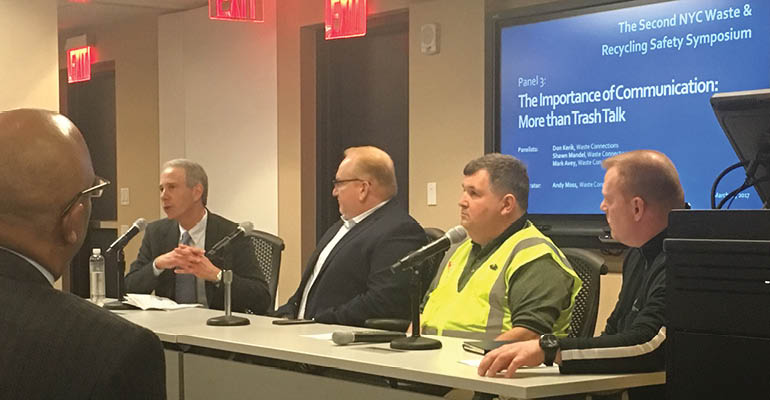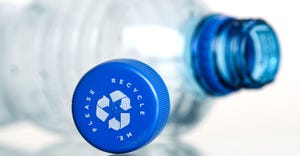Takeaways from the Second NYC Waste & Recycling Safety Symposium Program
At the event, industry experts and members of the law enforcement discussed a wide variety of safety topics, such as distracted driving, terrorism, backing, rollovers and collisions.

The Second NYC Waste & Recycling Safety Symposium Program, which was hosted by the Solid Waste Association of North America (SWANA), Action Environmental Services, the City of New York Business Integrity Commission (BIC), the National Waste & Recycling Association and the New Yorkers for Responsible Waste Management Inc., took place yesterday in New York. At the event, industry experts and members of the law enforcement discussed a wide variety of safety topics, such as distracted driving, terrorism, backing, rollovers and collisions.
Here are five takeaways from the Second NYC Waste & Recycling Safety Symposium Program:
1. SWANA CEO and Executive Director David Biderman kicked off the program by relaying the fact that the waste and recycling industry has the fifth highest fatality rate in the country, which equals out to one person a week.
In 2015, there were 50 industry worker deaths, 36 of which were collection fatalities. However, since August 2016, NYC has not had any fatal industry accidents.
Each year, more than 15,000 industry workers report injuries or illnesses, but many injuries and illnesses are unreported. And to avoid common injuries and illnesses, Biderman says the industry needs to find a balance between productivity and safety.
When it comes to collection worker fatalities, there are three most common causes: backing, rollovers and striking. For third-party fatalities, the three most common causes are drivers crossing into the path of a garbage truck, pedestrians and bikes colliding with garbage trucks in an intersection or while trucks are making a right turn and vehicles rear-ending the back of a garbage truck.
A large number of accidents these days are caused by distracted driving, and according to Biderman, leaders of the industry need to make sure that their drivers are not distracted because other drivers on the road are.
He also gave six key tips for improving safety:
Engage your drivers, helpers and other front line workers. Make safety personal for your workers and use photos and videos to reach employees.
Keep up with maintenance and pre-trips.
Utilize new technologies to improve route optimization.
Use SWANA’s Safety Monday tips, videos and posters to promote safety in the workplace.
Enforce the rule of no distracted driving.
Turn to personal protective equipment as the last line of defense.
To end the keynote panel, Biderman announced Ken Levine of Action Environmental as the new safety ambassador of SWANA’s NYC Chapter.
2. During the “See Something; Say Something: Eyes and Ears on the Street” panel, Deputy Chief of Intelligence for the Manhattan District Attorney’s Office Kevin Branzetti, Lieutenant for the New York Police Department (NYPD) Intelligence Bureau Lucas Miller and Deputy Commissioner of Legal Affairs and General Counsel for BIC Noah Genel discussed the dangers of terrorism and how members of the industry can do their part in helping to prevent terrorism attacks.
According to Branzetti, there is no face of terrorism and there is no specific look; it’s what people believe and what they do. And while there are many types of terrorism groups, ISIS is the millennial generation of terrorists.
Adding to that, Miller shared that ISIS has an online magazine that is hidden very well and has instructions on how to make bombs and suggestions on where to plant them. He also mentioned that everyone has "spidey sense" and the capability of detecting if something is wrong or seems out of place.
Miller also shared that the number one weapon used in recent terrorist attacks or attempts is trucks, and, as members of the waste and recycling industry, we are in possession of a possible weapon of destruction.
To ensure safety on routes, workers should keep an eye out for changes in the amount/type of waste collected on their routes and participate in the City of New York Department of Sanitation’s (DSNY) active shooter training, according to both Miller and Branzetti.
In the future, the NYPD would like to see GPS and video cameras installed in every sanitation truck to help them track the trucks in an event that a terrorism event occurs, Miller mentioned.
3. During the “Team Dynamics: The Important of a Good Wingman” panel, Nathan Brainard of the Insurance Office of America, Safety Manager for Mr. T Carting Corp. Paul Zambrotta, Jemaine “Buck” Ellison of Action Environmental and Director of Risk Management for Action Environmental Sal Mastriani shared examples of why it’s important to work as a team.
Brainard started the panel by sharing that Americans are more tempted to speed around garbage trucks than any other vehicle and that if you cannot prove that you’re innocent in the event of an accident, the big truck will always lose. And by spending money on a safety program and training, you will add value to your program and reduce the cost of your insurance.
Zambrotta stated that the most common incident that occurs on a route with a helper and a driver is backing and while helpers are often underappreciated, no great driver can be a great driver without the assistance of a helper.
To ensure safety on routes, Ellison stated that every helper and driver need to communicate with each other via hand signals, eye contact, whistles or another form of communication that works for them.
Ellison also shared that the most difficult time to work for a helper is between the hours of 2 a.m. and 3 a.m. because fatigue starts to kick in. Weighing in on that comment, Zambrotta states that there is no penalty for pulling over to take a break or grab a cup of coffee if you’re experiencing fatigue.
4. During “The Importance of Communication: More than Trash Talk” panel, Don Kerik, Shawn Mandel, Mark Avey and Andy Moss of Waste Connections explained how simple communication can go a long way.
Mandel started the panel with an important message of, “We are only as safe as our riskiest employee out there.” He also mentioned that if you see a stop that you shouldn’t be servicing for safety reasons, you need to speak up to your leaders for both your safety and others’ safety.
Avey stressed the importance of setting small goals first, promoting those goals and then celebrating those goals. He also stated that as a member of the industry, the biggest leap you need to make is head to heart.
Kerik, formerly an employee of IESI, shared that he has seen a difference in safety culture since the company was acquired by Waste Connections and that employees are now more empowered to be safe.
The panelists also shared that Waste Connections had its first fatality since the merger. Recently, a long-time employee was backed over by a subcontractor tractor trailer at a landfill in California.
Avey also shared that daily communication is key to keeping safety at the forefront at all times.
5. Closing out the program, DSNY Commissioner Kathryn Garcia spoke on various aspects of safety. She stated that safety is all about culture and that we need to talk the talk and walk the walk when it comes to safety.
Garcia also shared that pedestrians may be distracted but you have more responsibility because you are the biggest kid on the block.
She also stated that even if something takes longer to do safety, it’s always cheaper in the long run.
About the Author(s)
You May Also Like




